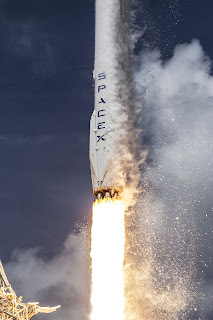SpaceX was introduced by entrepreneur Elon Musk in the goals of modifying the aerospace industry and making acceptable spaceflight a reality.
 |
| Credit: Getty Images |
Today's story is about SpaceX. How does SpaceX rocket work?
How does SpaceX make reusable and affordable?
SpaceX's first try at launches operated the Falcon 1, which utilizes one engine for every stage, the Merlin engine and the Kestrel Engine, both planned by SpaceX. The Merlin engine, which controls the main stage, initially used an ablative cooling technique, implying that the motor has a defensive covering that splits away as it ingests heat. However, after this strategy demonstrated risky, Musk changed the Merlin to incorporate a regenerative-cooling method, which is a typical cooling process that runs an exceptional coolant through the engine to reduce it of some warmth managing convection. This warmed coolant at that point fills in as a charge for the engine. SpaceX structured the primary stage segment of the rocket to fall to water with parachutes. That way the rocket is reusable, which makes different launches fully more affordable.
The next stage (otherwise called the upper stage) utilizes a Kestrel engine, which is cooled with both ablative material and a radiative-cooling method. Applied basically for low-push engines, radiative cooling utilizes dividers that support high temperatures. The warmth it assimilates then gets emanated off into the rocket's gases.
In March 2006 SpaceX made its first Falcon 1 transmission, which started effectively yet finished rashly because of a fuel hole and fire. At this point, be that as it may, the organization had just earned a large number of dollars in propelling requests, a significant number of them from the U.S. government. In August of that year, SpaceX was a hero of a NASA competition for support to manufacture and show rocket that might support the ISS after the decommissioning of the space transport. Falcon 1 launches that neglected to achieve Earth circle followed in March 2007 and August 2008, yet in September 2008 SpaceX turned into the main exclusive organization to send a fluid-filled rocket into space. A quarter of a year later it won a NASA contract for adjusting the ISS that was worth more than $1 billion.
The Falcon 9, the latest SpaceX Falcon, is likewise a two-stage rocket. In any case, the Falcon 9 is a lot bigger than the Falcon 1. Actually, it's so a lot bigger, The primary stage booster's nine engines deal with lift-off and convey the rocket to a height of around 100 km – just on the edge of the room. Here the successive stage separates and fires its own single-engine bring the payload into space. The principal stage comes back to Earth.
The Falcon 9 first-stage booster is outfitted with little engines close to its 'nose' that vent nitrogen gas. Not long after isolating from the subsequent stage, a controlled impact 'flips' the rocket to set it up for its arrival to the ground.
Flighty impacts of the earth, for example, changes in air pressure, mean the rocket's exact direction can't be worked out coming before transmission. Bird of prey 9's onboard computer needs to do it on the fly, and in a small amount of a second, prior to it comes up short on fuel. In any event, twelve sensors feed it data on the art's direction, position, speed, increasing speed and height.
The leading trial run of Falcon 9 was on June 4, 2010, from Cape Canaveral, Florida, and the ISS was made the first resupply mission on October 7, 2012. In 2014 tests started on a reusable first stage for the Falcon 9 that would arrive on a skimming stage. On December 21, 2015, a Falcon 9 propelled a payload into space, and its first stage made an arrival at Cape Canaveral. The principal Falcon 9 first-stage transport landing occurred on April 8, 2016, and SpaceX did its first relaunch of a formerly flown Falcon 9 first stage on March 30, 2017. The main Falcon Heavy dry run happened on February 6, 2018. The focal centre stage was not recuperated, yet the two side supporters effectively came back to Cape Canaveral. The payload, a Tesla Roadster, with a SpaceX spacesuit clasped into the driver's seat, was set into space around the Sun. A Falcon 9 propelled the main private maintained rocket, a Dragon conveying space explorers Doug Hurley and Robert Behnken, to the ISS on May 30, 2020.
Thanks for visiting.
What is SpaceX falcon?
The Falcon 1 was vastly less expensive to assemble and work than its opponents, a field to a great extent populated by rocket worked by freely maintained and government-financed associations, for example, Lockheed Martin and Boeing. Some portion of the rocket's cost-viability was made reasonable by the SpaceX-created Merlin engine, a cheaper alternative to those utilized by different companies. SpaceX additionally centred around making reusable rockets.In March 2006 SpaceX made its first Falcon 1 transmission, which started effectively yet finished rashly because of a fuel hole and fire. At this point, be that as it may, the organization had just earned a large number of dollars in propelling requests, a significant number of them from the U.S. government. In August of that year, SpaceX was a hero of a NASA competition for support to manufacture and show rocket that might support the ISS after the decommissioning of the space transport. Falcon 1 launches that neglected to achieve Earth circle followed in March 2007 and August 2008, yet in September 2008 SpaceX turned into the main exclusive organization to send a fluid-filled rocket into space. A quarter of a year later it won a NASA contract for adjusting the ISS that was worth more than $1 billion.
The Falcon 9, the latest SpaceX Falcon, is likewise a two-stage rocket. In any case, the Falcon 9 is a lot bigger than the Falcon 1. Actually, it's so a lot bigger, The primary stage booster's nine engines deal with lift-off and convey the rocket to a height of around 100 km – just on the edge of the room. Here the successive stage separates and fires its own single-engine bring the payload into space. The principal stage comes back to Earth.
What makes Falcon 9 differ from other rockets?
Here are some latest technologies which are used in Falcon9.
Cold-gas Thrusters (flip):
The Falcon 9 first-stage booster is outfitted with little engines close to its 'nose' that vent nitrogen gas. Not long after isolating from the subsequent stage, a controlled impact 'flips' the rocket to set it up for its arrival to the ground.
Engines:
The nine 'Merlin 1' engines of Falcon 9's first-stage promoter give the rocket the 600 tons of push required for lift-off. For security, the motors are masterminded in what SpaceX calls an 'octaweb' design – one focal motor encompassed by eight more. Every motor can adjust its point of push, to control pitch, yaw and move during rising, and for situating on the drop.Grid fins (directing):
Grid fins have the cross-section look of plastic tennis rackets, aside from everyone is the size of your kitchen table. After the main stage starts its 'boostback consume', restarting the three motors to slow its speed, these warmth safe wings jump out from the sides of the booster. They make minute developments to help steer the rocket towards the landing pad – somewhat like how skydivers can alter course with little motions of their hands.Fuel tanks:
Rocket first stages have generally used each drop of fuel to help their payload into space. Bird of prey 9's first stage conveys extra. After it flips more than, three of its motors reignite easing back the rocket's re-entry speed. These motors fire again as the rocket approaches the arrival stage. Through and through, the principal stage eases back from its top speed of 4,700 km/h to an arrival speed of only 20 km/h.
Onboard computer :
Flighty impacts of the earth, for example, changes in air pressure, mean the rocket's exact direction can't be worked out coming before transmission. Bird of prey 9's onboard computer needs to do it on the fly, and in a small amount of a second, prior to it comes up short on fuel. In any event, twelve sensors feed it data on the art's direction, position, speed, increasing speed and height.The leading trial run of Falcon 9 was on June 4, 2010, from Cape Canaveral, Florida, and the ISS was made the first resupply mission on October 7, 2012. In 2014 tests started on a reusable first stage for the Falcon 9 that would arrive on a skimming stage. On December 21, 2015, a Falcon 9 propelled a payload into space, and its first stage made an arrival at Cape Canaveral. The principal Falcon 9 first-stage transport landing occurred on April 8, 2016, and SpaceX did its first relaunch of a formerly flown Falcon 9 first stage on March 30, 2017. The main Falcon Heavy dry run happened on February 6, 2018. The focal centre stage was not recuperated, yet the two side supporters effectively came back to Cape Canaveral. The payload, a Tesla Roadster, with a SpaceX spacesuit clasped into the driver's seat, was set into space around the Sun. A Falcon 9 propelled the main private maintained rocket, a Dragon conveying space explorers Doug Hurley and Robert Behnken, to the ISS on May 30, 2020.
How SpaceX makes money?
Presently SpaceX is esteemed at over $30 billion and has in excess of 6,000 workers around the nation. The organization is propelling quickly, with a build-up of requests for its Falcon 9 and Falcon Heavy rockets. SpaceX is confronting its most prominent test yet in 2019: Launching space travellers for NASA. On the off chance that Musk's drawn-out objective of sending people to Mars will be acknowledged, SpaceX must have the option to normally and securely dispatch space travellers into space.Thanks for visiting.










